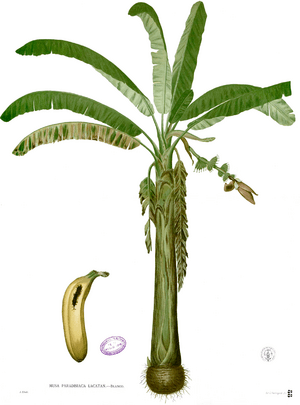Musaceae facts for kids
Quick facts for kids Musaceae |
|
|---|---|
 |
|
| Musa acuminata | |
| Scientific classification | |
| Kingdom: | |
| (unranked): | |
| (unranked): | |
| (unranked): | |
| Order: | |
| Family: |
Musaceae
|
| Genera | |
 |
|
| Musaceae distribution | |
The Musaceae are a family of flowering plants in the order Zingiberales. The family is native to the tropics of the Old World. The plants are large herbs with very big leaves; the lower parts of the leaves form a false stem so they look as trees.
The species of this family are native to the tropics of Africa, East Asia, Australia and South Pacific; some of them, like bananas and plantains, are grown in all tropical countries for their fruits.
Contents
Description
These are perennial herbaceous plants; they are not very tall. The lower parts of the big leaves are closely packed making a false stem (pseudostem) that is not made of wood. The true stems grow underground; it is called a rhizome or a corm. The false stems die after flowering and producing fruits and are replaced by new false stems rising from the underground corm.
The flowers have bracts and grow in groups (inflorescences) and are pollinated by insects, birds, bats and treeshrews.
Fruits are berries with many hard seeds but the fruits of commercial bananas and plantains do not have seeds because they are steriles.
Genera
The French botanist Antoine Laurent de Jussieu created this family in 1789.
There are three genera in this family:
Acceptance of Musella has varied; as of May 2013[update], the World Checklist of Selected Plant Families considers it a synonym of Ensete.
Uses
In addition to banana and plantain fruits and their products (including alcohol, meal), Musa species and varieties are important sources of fibre (abacá, Manila hemp).
See also
 In Spanish: Musáceas para niños
In Spanish: Musáceas para niños

